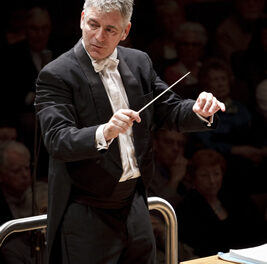 The Asheville Chamber Music Series presented its final concert of the season Friday night featuring the Neave Piano Trio. The musicians – Anna Williams (violin), Mikhail Veselov (cello), and Eri Nakamura (piano) – are currently alumni artists/faculty ensemble-in-residence at the Longy School of Music at Bard College. According to radio station WQXR, “‘Neave’ is actually a Gaelic name meaning ‘bright’ and ‘radiant,’ both of which certainly apply to this trio’s music making.”
The Asheville Chamber Music Series presented its final concert of the season Friday night featuring the Neave Piano Trio. The musicians – Anna Williams (violin), Mikhail Veselov (cello), and Eri Nakamura (piano) – are currently alumni artists/faculty ensemble-in-residence at the Longy School of Music at Bard College. According to radio station WQXR, “‘Neave’ is actually a Gaelic name meaning ‘bright’ and ‘radiant,’ both of which certainly apply to this trio’s music making.”
Valerie Poullette, the president of the board of the Asheville Chamber Music Series, welcomed the virtual audience to the concert, which was dedicated to the memory of the “father” of the ACMS, Joe Vandewart. Poullette also introduced in-coming president Marilynne Herbert who, in turn, provided an overview of next season’s lineup.
Neave violinist Williams, appearing with the other members of the trio in an apartment in Boston, gave some opening comments about the composer of the first work, Louise Farrenc (France, 1804-75). According to the program notes, by Diane Zolnaski, Farrenc was “the first woman appointed a professor of piano at the Paris Conservatoire and remained in that position until she retired in 1873. Farrenc was the only woman at the conservatoire to have a permanent music position of such importance in the 19th century.”
The style of Farrenc’s Piano Trio in E-flat, Op. 33 (1844), is certainly 19th century Romantic, with some solid footing in the Classical tradition. Indeed, there were some Beethovenesque features to the opening Allegro, which was taken at a nice brisk tempo. The playing displayed passion and lyricism in equal parts, with some humor thrown in for good measure. Indeed, one critic stated that the Farrenc Trio “is a happy blend of Beethoven, Weber, and Mendelssohn….”
The slow second movement featured lovely melodies from both violinist Williams and cellist Veselov. The Minuetto was a perky contrast, with lots of energy. The Neave played the Trio with lots of rhythmic flexibility. The Finale Vivace brims with good humor, evident in this performance.
The three musicians breathed as a unit, resulting in great ensemble; the writing is well-distributed among all three instruments. Pianist Nakamura, especially, had lots of virtuosic and brilliant parts, beautifully played.
The recording was made in the Fraser Performance Studio, run by WGBH radio station in Boston. The video was first rate, capturing each musician in important moments, as well as the entire trio playing together. One could have asked for more sonic presence, especially from the strings.
Up next was Piano Trio No. 1, Op. 11 (1881), by Cécile Chaminade (France, 1857-1944). According to the program notes, Chaminade was a virtuoso pianist, giving concerts in Europe and England. “In contrast to the other women composers on this program, most of Chaminade’s oeuvre of roughly 400 works were published. Her music became very much in vogue, especially in the United States and England. She even performed for Queen Victoria. Chaminade was inducted into the Légion d’honneur in 1913. This was the first time the légion had chosen a female composer.”
What a difference a half century of music composition makes! For one thing, the music is much more passionate and virtuosic, not a problem for the Neave Trio; they simply switched hats. The opening Allegro is flowing but agitated with drama; some critics have pointed out an affinity with Brahms. The slow movement is song-like, with lovely melodies, expressively played by all musicians.
The flying Presto (Scherzo), in a major mode, highlighted the fleet fingers of Nakamura, whose playing was unerring. The finale returns to the minor mode, with more passion and lyric outpouring, dramatically played by the Neave.
After a five-minute intermission (why do we do this for a streamed performance?), the Neave Trio answered some questions that were previously submitted about their training, how the pandemic has affected the group’s morale, their practice and performing. This Q&A was a good way to get to “know” the individuals in the group.
The musicians were “humbled and honored” to be able to play the three-movement 1921 Piano Trio by Rebecca Clarke (England, 1886-1979). The composer attended the Royal Academy of Music but moved to the United States (her father was an American citizen) in 1916 to pursue her performing career as a virtuoso violist.
The arresting opening catches the listener’s attention with its intensity. This music returns several times throughout the piece. The second theme brings sumptuous melodies to cello and violin, passionately presented.
The slow movement begins with expressive melodies from the strings. A wonderful “misty” texture comes with the second theme. The finale begins as a rocking romp, with a somewhat “Asian” folk character expressed through pentatonic scales. But it is much more than that. Lovely, tranquil moments interrupt the energy.
The evening concluded with more pre-recorded Q&A with the Neave. The take-away was that this was a wonderful evening of well-executed performances of works that are all-too-infrequently programmed. Bravo to the Neave Piano Trio for having the love (and guts) to present such eye-opening, committed dedication to these deep and meaningful works.











